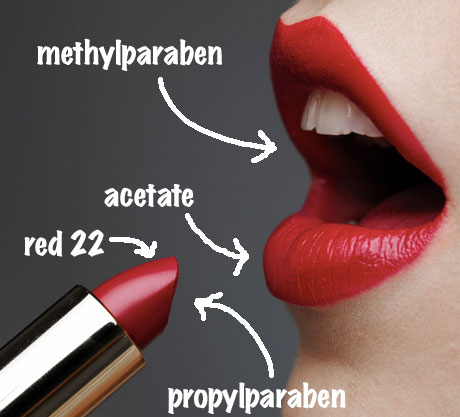Almost everyone knows that the make-up routine is NOT complete without the finishing touches of a carefully pondered and selected lip color. Lip colors can help tone down a dramatic look or pump-up a rather simple ensemble for a perfect balance of confident, sexy and/or daring. However, have you considered lately what might be in your stick of color splash? Here are a few ingredients common to lip products with synthetic additives:
Synthetic emollients such as forms of vitamin A (retinyl palmitate or retinyl acetate) and tocopheryl acetate (vitamin E mixed with acid) as well as Petroleum-based emollients like mineral oil and petrolatum provide moisturizing effects. Natural Alternatives include plant-based emollients such as; shea butter, cocoa butter, avocado, and aloe vera.
Synthetic Fragrance is sometimes added to mask the smell of other ingredients or enhance the smell of flavored lip products. Synthetic fragrances are not required on the label and may contain allergens or irritants. Natural fragrances include vanilla and peppermint.
Preservatives are used to extend the shelf-life of lip products. Synthetic preservatives such as formaldehyde, BHT, and parabens typically offer a longer shelf-life than natural preservatives, however these components have been linked to cancer, endocrine disruption (affects reproductive system), other toxic effects, and a range of health problems . Natural preservatives include vitamin E, tea tree oil, neem oil and cinnamon. .
Tocopheryl Acetate, also known as vitamin E acetate, is used in a variety of products, including lipstick, moisturizer and foundation. The Cosmetics Database rates it as a “moderate hazard” because it may cause itching, burning, scaling, hives and skin blistering, and may be toxic.
Colorants, such as D&C Red 36 (rated “low hazard”), and D&C Red 22 Aluminum Lake (rated “moderate hazard”) are typically tested on animals, and have raised concerns because some research has linked exposure to nervous system damage and other health concerns. Natural colorants can be extracted from plants and fruits.
Botanical and mineral-based lip products come in a variety of colors, and are available online from natural food and cosmetic retailers, and some larger department stores. These healthier/natural options are cost comparable ( long term) to the main-stream chemical laden options when avoiding accidental ingestion of chemicals, petroleum or heavy metals.
Stay beautiful Inside and Out!
